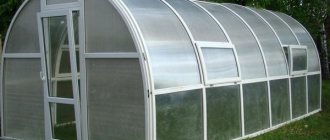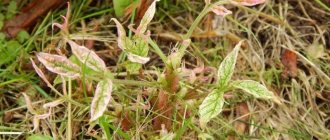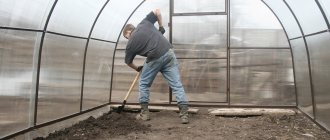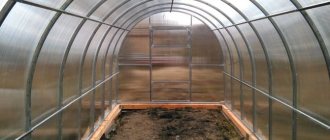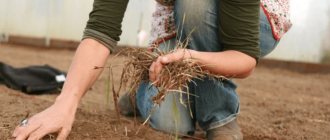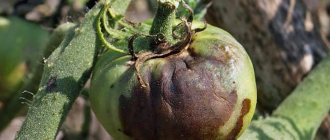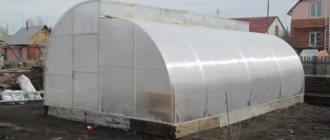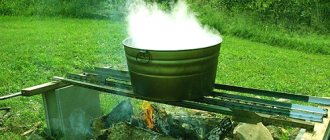With the onset of autumn cold weather, summer residents begin to think about what work needs to be done in the greenhouse and how to properly prepare it for the next season.
This is very important, since the future harvest depends on the correctness of the actions performed. Experts tell you how to prepare a greenhouse for winter after growing tomatoes and cucumbers. Dear readers! For you, we have created communities on social networks in which useful articles and interesting ideas are published several times a day! Subscribe and receive useful content in a convenient format!
Why treat a greenhouse in the fall?
This question could be called stupid if it were not for its obviousness. Naturally, because every gardener must remove all unnecessary things from his garden. Typically, autumn garden care requires a special calendar of work: the greenhouse is processed not only in the fall, but also in the spring. In the fall - in order to prepare the room for winter. Proper treatment of the greenhouse will help not only get rid of harmful insects and diseases, but will also significantly save time in the spring: you will not have to do work when you need to plant young trees as soon as possible.
Is digging the soil necessary in the fall?
Many gardeners do not dig up the soil in the fall, and this is a mistake. This point is important when treating the soil against diseases and pests. In addition, the food that was added earlier will work better if it is mixed with soil.
When digging, the pest larvae rise to the ground, and with the first frost they freeze. Just dig up the soil not before frost, but earlier, after harvesting. Before the first cold weather, the larvae go deeper into the soil and a shovel will no longer reach them, only deep cultivation of the soil with a plow.
Stages of preparation for the next season
Before you start processing your greenhouse, first prepare for the process. It’s not difficult to treat a room, the main thing is to know and follow the sequence of steps:
- Cleaning procedure (cleaning and digging the soil during autumn work).
- Washing (metal frame and polycarbonate).
- Treatment of premises and soil with chemical, biological preparations or folk remedies.
Autumn cleaning in the greenhouse
First, you need to get rid of all plant debris: during the summer season, the greenhouse stores a lot of remnants of wilted plants and weeds. But they nevertheless still harbor all sorts of pathogens and diseases. Not only faded crops are harvested, but also the mulch layer: over the entire period of use it becomes rotted and unusable. Wet mulch can become a source of late blight infection. Therefore, remove it. During cleaning, it is necessary to temporarily remove supports, pins and coverings. The film covering of the greenhouse is a little simpler: it can be easily removed, washed separately, dried and stored.
Digging of the soil is carried out after the preliminary use of disinfectants. Soil disinfection is a vital procedure that helps destroy any larvae that have gone to winter. It also destroys pathogens. How to do the soil digging procedure:
- Stick in the shovel. This depth is optimal for digging the soil.
- Change the top layer if the time has come. The top soil layer is removed approximately every 3 years. And replace it with a new one (can be purchased at a farm store). The old layer can be thrown away or composted.
Processing of greenhouse structures
Most often, a polycarbonate greenhouse is used for growing: it is more durable. But it is also more demanding in terms of care. Processing a polycarbonate greenhouse in the fall includes several rules. Without following them, you risk damaging the coating and the frame itself. In order to properly wash a polycarbonate greenhouse, you don’t need too much:
- Broom or broom (for cleaning remnants of cobwebs in hard-to-reach places).
- Telescopic mop for windows (for cleaning the coating inside).
- Microfiber cloths, soft sponges (for washing).
It is the internal cleaning of the greenhouse that is more important. The outside of the greenhouse can be washed with plain water, because the main process takes place inside. What compositions or means are suitable for washing the frame: water with diluted laundry soap or water with dishwashing detergent. The detergent composition is applied to the coating for no longer than 10 minutes, then washed off with water. The same procedure is carried out with garden tools that are still suitable for use.
Important: polycarbonate greenhouses are washed only with soft sponges or microfiber cloths. The use of iron sponges and silencers will cause significant damage to the coating.
Solutions for cleaning greenhouse walls
You can wash the greenhouse with anything, as long as you follow the correct dosage. Composition options:
- Soap and water (a bar in a bucket).
- Dishwashing liquid and water.
- Potassium permanganate solution and water.
- Baking soda diluted in water.
- Glass cleaner.
- Chloride of lime (400 grams per 10 liters of water).
Disinfection of soil in greenhouse beds
Another equally important procedure in autumn gardening. The future growth of seedlings next year depends on the condition of the soil. The healthier it is, the better it is for you. Soil disinfection helps not only to get rid of insect larvae, but also to destroy mold. You can disinfect soil using chemicals, biological agents or traditional methods. The soil disinfection procedure is carried out along with the greenhouse disinfection procedure.
Attention: when cultivating the soil and greenhouse, be sure to wear personal protective equipment so that the toxic vapors of the drugs do not penetrate the body. Afterwards, rinse your mouth well, wash your face and hands. The maximum time for disinfection is no more than 10 minutes. Afterwards, be sure to ventilate the room.
Biological products
Summer residents like such preparations because they are non-toxic and do not accumulate in the soil. Good drugs:
- Vermitex (saves from spider mites, aphids).
- Trichodermin (100 ml per 10 liters of water).
- Alirin-B (one tablet per bucket).
- Baikal EM-1 (destroys pathogens).
- Treatment with phytosporin.
Herbal infusions
How to treat a greenhouse against pests? This is a question many gardeners ask themselves. And many people have known folk methods since time immemorial, for example, infusions of herbs and other crops. Most often, summer residents use decoctions and infusions from:
- Mustards.
- Luke.
- Garlic.
- Dandelion.
- Hot pepper.
Sowing green manure
Green manures are natural green fertilizers, sources of nitrogen and other useful microelements. They are sown after digging the soil and disinfecting it. When they fade, there is no need to remove them, just cut them off lightly.
Biology to the rescue
To disinfect the soil, it is advisable to use natural healing methods. This means that only natural factors should be used, without adding artificially created chemicals.
Means that reduce the number of pathogens in the substrate include, first of all, thermal ones, including:
- steaming the soil is a rarely used technique for greenhouses due to its labor intensity; the top layer of the bed is removed and placed in a container permeable to steam and fixed over a vessel with boiling water for half an hour to an hour, which is how to eliminate microbes;
Thermal treatment of soil
- freezing of the soil - in most cases occurs naturally in areas with low winter temperatures - if the greenhouse is not dismantled for the winter, the soil freezes stronger than in open ground due to the absence of a snow “blanket”, which helps destroy microbes and fungi.
Thermal methods destroy not only harmful microorganisms, but also those that make the earth alive, so subsequent enrichment activities are required.
Such actions include another method of soil disinfection - the colonization of beneficial flora and fauna, i.e., the introduction of preparations containing colonies of the necessary bacteria. These products include all varieties of drugs “Baikal”, “Baktofit”, “Trichodermin”, etc. All of them naturally suppress the pathogenic microcosm of the soil and at the same time enrich it.
Baikal EM 1
Baktofit - biological fungicide and bactericide
The most effective way to biologically restore the soil is considered to be a timely change of soil. At the same time, they replace the soil in the greenhouse not with a substrate purchased in a store, but with a home-made composition - compost.
Replacing soil in a greenhouse
It is known that during the process of rotting, plant residues mixed with old soil (taken out of the greenhouse), as well as manure and purposefully applied fertilizers or soil enrichers, undergo many processes during the composting process (fermentation, rotting, processing by bacteria and worms, mixing, heating, hydration and many others). All this results in better soil composition - high quality soil, free of pathogens and rich in nutrients. Therefore, a compost heap (pit, stack) must be built in every garden plot.
Compost heap organization diagram
Important! The owner of a personal plot must know how to create ideal soil using composting.
Example of a compost heap
Three ways to disinfect a greenhouse
Various drugs and folk methods will help destroy fungal pathogens and late blight. According to their classification, they are divided into:
- Fumigation.
- Heat treatment.
- Spraying.
Each method is useful in its own way, depending on what exactly you are trying to get rid of.
Spraying
The walls of greenhouses are treated with this composition. The smallest particles of the solution reach the most remote corners of the room and destroy the causative agents of late blight and other garden diseases. Most often, a solution of copper sulfate is used for these purposes. This product is almost universal, since it can be used to treat not only structures, but also soil. Vitriol is taken at the rate of 100 grams per 10 liters of water. To consolidate the result, it is better to repeat the procedure after a couple of weeks. Another good drug is Percel-6.
Fumigation of greenhouses
This procedure is carried out using special checkers: sulfur or tobacco (they will be discussed in more detail below). The smoke released during smoldering is extremely toxic both for diseases and for the person himself, so do not stay in the room for more than 10 minutes. Use PPE.
Sprinkling with powder mixtures
These compounds are used to disinfect soil. Slaked lime is recognized as one of the best. Only it needs to be applied in a thin layer, no more than 200 grams per 1 square meter. m. After the lime is evenly distributed over the soil, it is dug up.
Mechanical means of soil disinfection
One of the methods is traditional - this is thermal treatment with steam (more details below). The second method is to install special devices: electrical or on an electrode. However, as practice has shown, they are ineffective; moreover, these devices do not have a certificate from the Ministry of Agriculture.
Planting green manure in autumn
Green manure is a budget-friendly and easy way to enrich the soil with microelements, saturate it with oxygen, nitrogen, and bioorganics. After treating the soil with drugs against diseases and pests, plant a mixture of green manure: oats, buckwheat, vetch, mustard and others. In addition to saturating the soil, they “drive away” and cleanse the garden of weed roots, wireworms and other pests.
Green manure does not need to be grown to the point of flowering: we need a root system and a little green mass. As soon as the plant growth has reached 10-30 cm (as long as you have time before the cold weather), immediately embed it in the soil by digging again.
Treatment of greenhouses and greenhouses from pests and diseases in the fall without replacing the soil
This type of treatment is preventive. If you just imagine for a second how many layers of earth will have to be removed when replacing the soil, then this method suggests itself. Means for autumn disinfection use chemicals, but are based on the purpose of treatment:
- From insects.
- From diseases.
The most popular means is copper sulfate. For soil, take a less concentrated solution: 1-1.5%. If you want to destroy mold or bacteria, use Previkur. Just keep in mind that treatment must be carried out not only in the fall, but also in the summer, several times a season.
Chemical Selection
Processing greenhouse greenhouses is a painstaking and time-consuming process. And the better you treat the room, the longer you will be calm. As a rule, chemical agents are used to destroy pathogens: they are more aggressive towards them. Most popular:
- Abiga Peak.
- Consento.
- Spraying with Bordeaux mixture.
- Copper oxychloride (at the rate of 40 grams per 10 liters of water).
- Spark.
- Karate and others.
Biologically active agents
Such substances are safe for people and animals. The most popular drugs are Fitosporin and Trichodermin. How to use: water the beds.
Folk methods and means of struggle
Many summer residents do not want to turn to “chemistry” for fear of harming or accumulating the drug in the soil, so they use their own methods. What do they use most often:
- Infusions: tobacco, garlic, onion.
- Solutions: vinegar or soda.
- Heat treatment.
Conservation and care in winter
Having cleared the greenhouse of debris and disinfected it, you might think that the autumn preparation of the plant house has been successfully completed. But that's not true. It remains to physically prepare the greenhouse for the upcoming cold weather, snowfalls, and winds. This is especially important for polycarbonate structures.
Take care to strengthen the frame of the greenhouse. Yes, most modern structures are not afraid of the high pressure that will be created by a thick snow cover, comfortably located on the roof of the greenhouse. But it is unlikely that such a roof will withstand a load of more than 400 g/m2. And it may not even be the covering material itself that fails, but rather the frame of the structure. It would be a shame if all your work on building a greenhouse or the money spent on purchasing it simply went down the drain because of laziness that prevented you from putting up supports.
Failed greenhouse
Attention! The frame should be strengthened by installing additional supports in the greenhouse even in those regions where there is little snow and warm winters. Believe me, you will sleep much more peacefully in this case.
During the winter, sometimes a lot of snow falls in some regions, and in order not to rush to the dacha after each snowfall, just put up supports - this way the greenhouse will last until spring.
Step 1. Cut pieces of wood to the required length - they should be the height of the greenhouse itself.
First you need to prepare wooden blocks
Step 2. Firmly install supports under the frame arches and joists every 1.5 meters minimum.
The distance between supports must be at least 1.5 m
Tip To avoid stripping the paint from the metal, you can place a piece of thick rubber between it and the wooden support. This will prevent unnecessary sliding and at the same time protect the paint on the frame from damage.
Strengthening the greenhouse frame
Step 3. If possible, secure the supports with something so that they do not fall under pressure and pierce the greenhouse covering if they suddenly jump out from under the frame.
How to install supports under the frame
Step 4. Place a brick under the base of the support, which will help it not move or sink too deep into the ground.
Advice! If your greenhouse is covered with polycarbonate and you have the opportunity to come to your summer cottage and clean off the snow after every heavy snowfall, do not neglect it.
Be careful not to scrape the snow with sharp objects to avoid damaging the coating. You can easily damage the layer that protects polycarbonate from exposure to ultraviolet radiation.
Clearing the greenhouse
By the way, some gardeners remove any covering from greenhouses, but this is not always convenient or easy to do. Therefore, it is better to thoroughly prepare the house for the plants for wintering and not give yourself extra work, which is already enough.
Attention! The cleaner the coating, the easier it is for snow to roll off naturally.
Video - Preparing the greenhouse for winter
Cleaning a polycarbonate greenhouse in the fall
In this article you will find everything you need to know about autumn cleaning of a polycarbonate greenhouse! We also recommend reading the article on how to prepare soil in a greenhouse for tomatoes.
As you can see, autumn preparation of a greenhouse is not so simple. But the difficulty lies not in the processing methods themselves, but in their quantity. The work itself is not so difficult to carry out. The main thing is to do everything step by step, and then you will be able to most correctly and efficiently prepare the greenhouse for winter and the next summer season.
Disinfection of a greenhouse in spring
Preventive work on cleaning and disinfecting a greenhouse in the spring is no different from the autumn and includes the same steps: cleaning and washing; disinfection of metal frames; coating it with anti-corrosion; disinfection of the coating with phytosporin; soil disinfection with slaked lime or copper sulfate solution (3-5%).
Solutions for disinfecting coatings
To protect the coating from mold, moss and other troubles, use a strong solution of potassium permanganate or a solution of chlorine of lime.
Frame disinfection solutions
If the greenhouse is unpainted, use 1% Bordeaux mixture (spraying) for disinfection. A solution of potassium permanganate, formaldehyde, copper sulfate and quicklime also do a good job of this.
Fumigation with sulfur bombs
This method is toxic, but effective. But remember that they cannot be used in greenhouses with a metal frame or an unpainted frame. Use the checker strictly according to the instructions: about 9 checkers are suitable for a small greenhouse 3*6. They have a wick. Place the checkers strictly in all corners of the greenhouse on surfaces that prevent combustion. Close all the windows and doors so that not even a particle of air gets in. Then light the wick. Approximate smoldering time is 5 hours. After the checker has decayed, leave it for three days. Afterwards, ventilate the room well and wash the inside with a soap solution.
Fumigation with tobacco sticks
In principle, the method is almost no different from using sulfur bombs, just remember that the best effect can be achieved in a humid environment. Therefore, spray the soil and interior surface with water before use. Next, proceed to fumigation:
- Seal the room.
- Place checker stands in the corners: bricks or metal utensils.
- Light the wick outside and wait a minute. Then bring the checker into the greenhouse and place it on a stand.
- Wait a few hours and then ventilate the room.
The need for soil disinfection
During the gardening season, high temperatures and humidity prevail in the greenhouse. In such an environment, all life processes are very active. This applies not only to cultivated plants, but also to soil microorganisms and insects. Moreover, both useful and harmful. In the process of their vigorous and interconnected activity, the soil is greatly depleted. Harmful substances accumulate in the upper layer, where it is warm and humid. The causative agents of various diseases are also concentrated in the ground, on the walls, glass and frame of the greenhouse. Therefore, disinfection should be carried out at the end of each gardening season.
Additional treatment and disinfection of the greenhouse in the fall
After you have washed and cleaned the frames, proceed with the additional disinfection procedure. This will consolidate the results from the previous stages. Once you have disinfected the soil, dig up the top soil and carry out the freezing procedure. This will help get rid of most of the pathogens.
Biological products for tillage in autumn
Water the soil with a solution of copper sulfate. Then, pour plenty of phytosporin solution, because copper will destroy not only diseases, but also beneficial bacteria. There are also special ready-made preparations that are known to many. You just need to use them in cloudy, warm weather. List:
- Trichoderma.
- Alirin.
- Maksim.
- Alatar and others.
How to treat a greenhouse in the fall against ants and aphids
These insects are not only annoying, but also dangerous. Especially when they are adjacent to each other. It’s not for nothing that aphids are called “ant cows”: it provides them with a valuable and nutritious product: honeydew. Aphids are to ants what a cow is to us. In this regard, aphids and ants are always an advantageous neighbor: they protect them, help them move to a new place and literally fight to the death for a drop of that same dew. This all sounds interesting, of course, but if they are not destroyed, your seedlings will die. Use everything you can: folk remedies and drugs:
- Soil treatment with Karbofos.
- Freezing the top layer.
- Sulfur checker.
- Preparation Spark, Kinmiks, Anteater, Ant.
- Ammonia solution (200 ml per bucket of water). Spray the soil.
- Infusion of fermented nettle: kilogram per 10 liters of water. Spray from a spray bottle.
- Tobacco mixed with ash and water: 200 grams per 10 liters of boiling water. Leave for a day and spray.
How to disinfect a polycarbonate greenhouse in the fall from clubroot, gallonweed, and blackleg
The simplest method is spraying with phytosporin or a solution of potassium permanganate. The drug Karbofos helps get rid of nematodes and blackleg. Dosage: 90 grams per 10 liters. Carbation diluted in water at a dosage of half a kilo per bucket of water will help get rid of clubroot. Before use, dig up the soil and water it with the preparation.
How to treat a greenhouse against late blight
Late blight is almost in first place in terms of danger and speed of spread. “Thanks” to her, more than one tomato crop has perished. Infected bushes can only be thrown away and burned. But in order not to do this, it is better to prevent the disease. How:
- Carry out standard activities: remove plant debris, dig up the soil, destroy or treat garden tools.
- You can replace the top layer of soil by moving it outside the room.
- Water the beds with 1% Bordeaux mixture.
- Instead of Bordeaux, you can use steaming: pour boiling water over the beds, cover with polyethylene and leave for 2 days. After the procedure, pour vitriol, sprinkle with dry lime and dig.
- Fumigate with sulfur.
- If the infection is severe, use formalin.
What pathogenic organisms overwinter in a greenhouse?
When planning autumn events, it is important to understand exactly what pests and pathogens of dangerous diseases remain in the greenhouse for the winter and what conditions they need for this.
Aphid
These insects drink the juice of cultivated plants. In the greenhouse they multiply quickly, parasitizing young shoots. During their life, insects secrete a sweet, sticky liquid on which harmful fungi develop.
During the winter, aphids lay eggs on plant debris. With the onset of positive spring temperatures, the eggs hatch into larvae, which then turn into adults. Aphids can be hidden in their nests by ants, who feed on its sweet secretions, using it as a milk cow.
When planning measures to combat aphids, it is necessary to simultaneously expel ants from the greenhouse.
Whitefly
It has a size comparable to an aphid, but can fly. White insects settle in large numbers on young plants and drink their juice. When overwintering in a greenhouse, the insect can withstand temperatures down to minus 5 degrees.
- In regions with frosty winters, you can destroy wintering individuals by freezing, creating a temperature in the greenhouse below 5 degrees below zero.
- In southern areas you will have to use a chemical agent.
Spider mite
The insect is small in size, but capable of destroying plants in a short period of time. It feeds on plant sap, leaving small dots on the underside of the leaf. It leaves a thin web where the leaves are attached.
The adult insect overwinters in various crevices or in debris. Folk remedies and acaricides are used against ticks.
Slugs
They have a gnawing type mouthparts. During the day, slugs sit in secluded places, and at night they go out hunting, gnawing on young shoots, leaves and fruits.
Slug larvae remain in the soil layer and can be destroyed with hot water or chemicals.
Nematode
The pest belongs to the class of roundworms. Small, barely noticeable worms parasitize the roots and stems of vegetable plants, causing great damage to the crop.
It's difficult to fight her. For wintering, roundworms are located in the thickness of the earth, at a depth of 20 cm, or remain in galls - thickenings on the root system.
Fungal infection
These include:
- late blight,
- cladosporiosis,
- fusarium,
- powdery mildew,
- numerous types of rot.
The disease occurs under poor growing conditions and quickly spreads on plants, taking away a significant part of the crop. It is not easy to fight it, since the fungi have become resistant to chemicals.
They spend the winter in the greenhouse on equipment, on the soil and walls of the room. Drugs that belong to the group of fungicides are effective in the fight.
Viral and bacterial infection
They are brought into the greenhouse with seeds, soil and insects. Therefore, preventive measures in this case include:
- cleaning of plant fragments;
- application of insecticides;
- use of drugs against bacteria.
What is crop rotation and why is it needed?
The ideal solution for many summer residents is to have not one greenhouse, but two. But, given the size of many areas, only one can be placed.
Cultivating the same plants every year in a permanent place leads to depletion and contamination of the soil. For example, late blight spores that attack tomatoes persist in the ground for several years.
Since many summer residents do not have crop rotation, and pathogens and microorganisms accumulate during the growing season, it is necessary to carry out disinfection and preventive maintenance of the soil and the entire greenhouse as a whole.
What methods of disinfection exist? Here are 5 ways to help put your greenhouse in order.
Disinfection of greenhouse structures
Wet cleaning implies not only the cleaning of contaminated upper surfaces, but also disinfection.
To do this, use a brush or sponge to clean all surfaces outside and inside, removing all dirt, soil, cobwebs, etc.
A soap solution using tar soap or shampoo is very effective. The solution is left on the surface for 10-15 minutes. This time is enough for fungi, spores and viruses to die.
Pour boiling water over metal surfaces, and treat wooden surfaces, containers, and garden tools with a 5%-10% solution of copper or iron sulfate.
